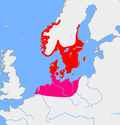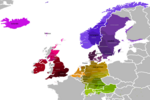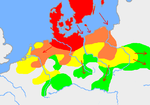 | The West Germanic languages constitute the largest of the three branches of the Germanic family of languages (the others being the North Germanic and the... 57 KB (4,752 words) - 23:00, 22 April 2024 |
the Germanic parent language (GPL), also known as Pre-Germanic Indo-European (PreGmc) or Pre-Proto-Germanic (PPG), is the reconstructed language of the... 11 KB (1,247 words) - 19:35, 5 March 2024 |
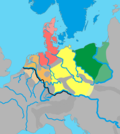 | descendants. Ingvaeonic is named after the Ingaevones, a West Germanic cultural group or proto-tribe along the North Sea coast that was mentioned by both... 10 KB (1,100 words) - 09:07, 9 April 2024 |
 | and proto-languages. North Sea Germanic Weser–Rhine Germanic Stefan Müller, Germanic syntax: A constraint-based view, series: Textbooks in Language Sciences... 6 KB (483 words) - 05:49, 6 April 2024 |
Proto-Germanic paganism was the beliefs of the speakers of Proto-Germanic and includes topics such as the Germanic mythology, legendry, and folk beliefs... 72 KB (1,709 words) - 02:57, 14 December 2023 |
of Proto-Germanic grammar, as inherited from Proto-Indo-European grammar. All reconstructed forms are marked with an asterisk (*). Proto-Germanic had... 59 KB (6,256 words) - 20:49, 13 April 2024 |
 | The North Germanic languages make up one of the three branches of the Germanic languages—a sub-family of the Indo-European languages—along with the West... 57 KB (5,429 words) - 10:22, 25 March 2024 |
branches: East Germanic languages North Germanic languages West Germanic languages They all descend from Proto-Germanic, and ultimately from Proto-Indo-European... 15 KB (1,120 words) - 00:22, 20 January 2024 |
alternation is the English plural foot ~ feet (from Proto-Germanic *fōts, pl. *fōtiz). Germanic umlaut, as covered in this article, does not include... 52 KB (5,283 words) - 23:04, 25 March 2024 |
is not enough evidence for the sound.: 107 The Proto-Germanic */z/ is also preserved in the language as a sibilant (always found written ⟨s⟩ or as part... 32 KB (2,185 words) - 03:44, 11 February 2024 |
A-mutation is a metaphonic process supposed to have taken place in late Proto-Germanic (c. 200). In a-mutation, a short high vowel (*/u/ or */i/) was lowered... 12 KB (1,525 words) - 05:00, 27 April 2024 |
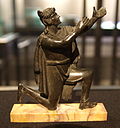 | the use of ancient and early medieval Germanic languages and are thus equated at least approximately with Germanic-speaking peoples, although different... 163 KB (20,172 words) - 09:20, 29 April 2024 |
The Germanic language family is one of the language groups that resulted from the breakup of Proto-Indo-European (PIE). It in turn divided into North,... 29 KB (2,932 words) - 16:56, 19 April 2024 |
it claims that Proto-Germanic may have been either a creole or a contact language that subsumed a non-Indo-European substrate language, or a hybrid of... 14 KB (1,707 words) - 13:34, 8 April 2024 |
Verner's law (category Articles containing Proto-Germanic-language text) characters. Verner's law describes a historical sound change in the Proto-Germanic language whereby consonants that would usually have been the voiceless fricatives... 20 KB (2,176 words) - 06:57, 14 April 2024 |
of the Germanic languages List of ancient Germanic peoples and tribes Germanic languages Proto-Germanic language, a reconstructed proto-language of all... 797 bytes (121 words) - 17:25, 11 December 2021 |
[ð] but, in most sources discussing Proto-Germanic, it is spelled ⟨d⟩ by convention. In the West Germanic languages, the suffix hardened to [d], but it... 60 KB (5,117 words) - 07:44, 14 March 2024 |
 | Runes (redirect from Germanic rune) from Proto-Germanic, and the source of the term for rune, riimukirjain, meaning 'scratched letter'. The root may also be found in the Baltic languages, where... 68 KB (6,930 words) - 17:48, 30 March 2024 |
Grimm's law (redirect from First Germanic sound shift) First Germanic Sound Shift) is a set of sound laws describing the Proto-Indo-European (PIE) stop consonants as they developed in Proto-Germanic in the... 22 KB (1,687 words) - 11:47, 24 March 2024 |
Holtzmann's law (category Articles containing Proto-Germanic-language text) Holtzmann's law is a Proto-Germanic sound law originally noted by Adolf Holtzmann in 1838. It is also known by its traditional German name Verschärfung... 7 KB (761 words) - 00:11, 15 January 2024 |
 | characters. Proto-Indo-European (PIE) is the reconstructed common ancestor of the Indo-European language family. No direct record of Proto-Indo-European... 62 KB (5,736 words) - 04:48, 21 April 2024 |

